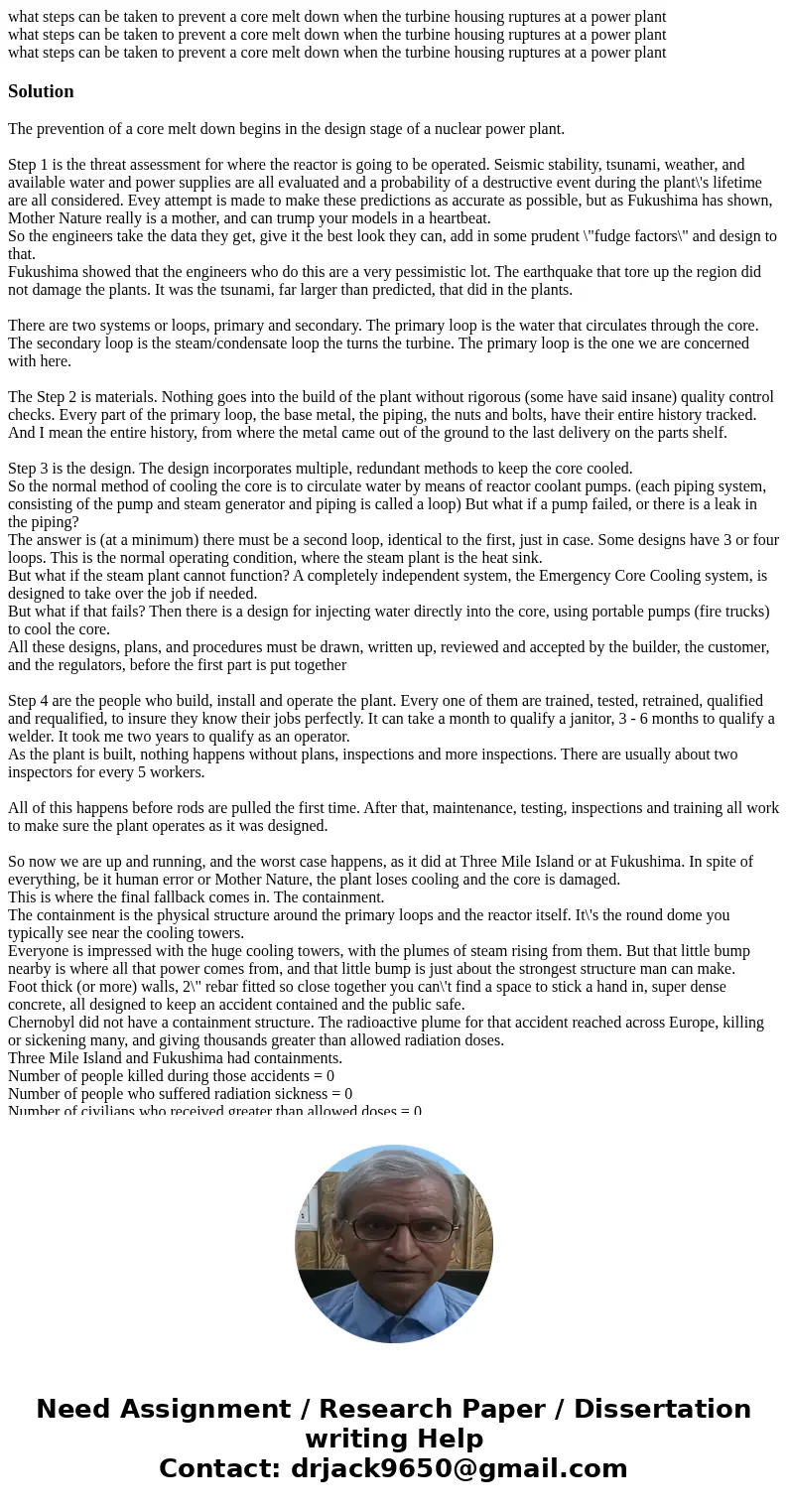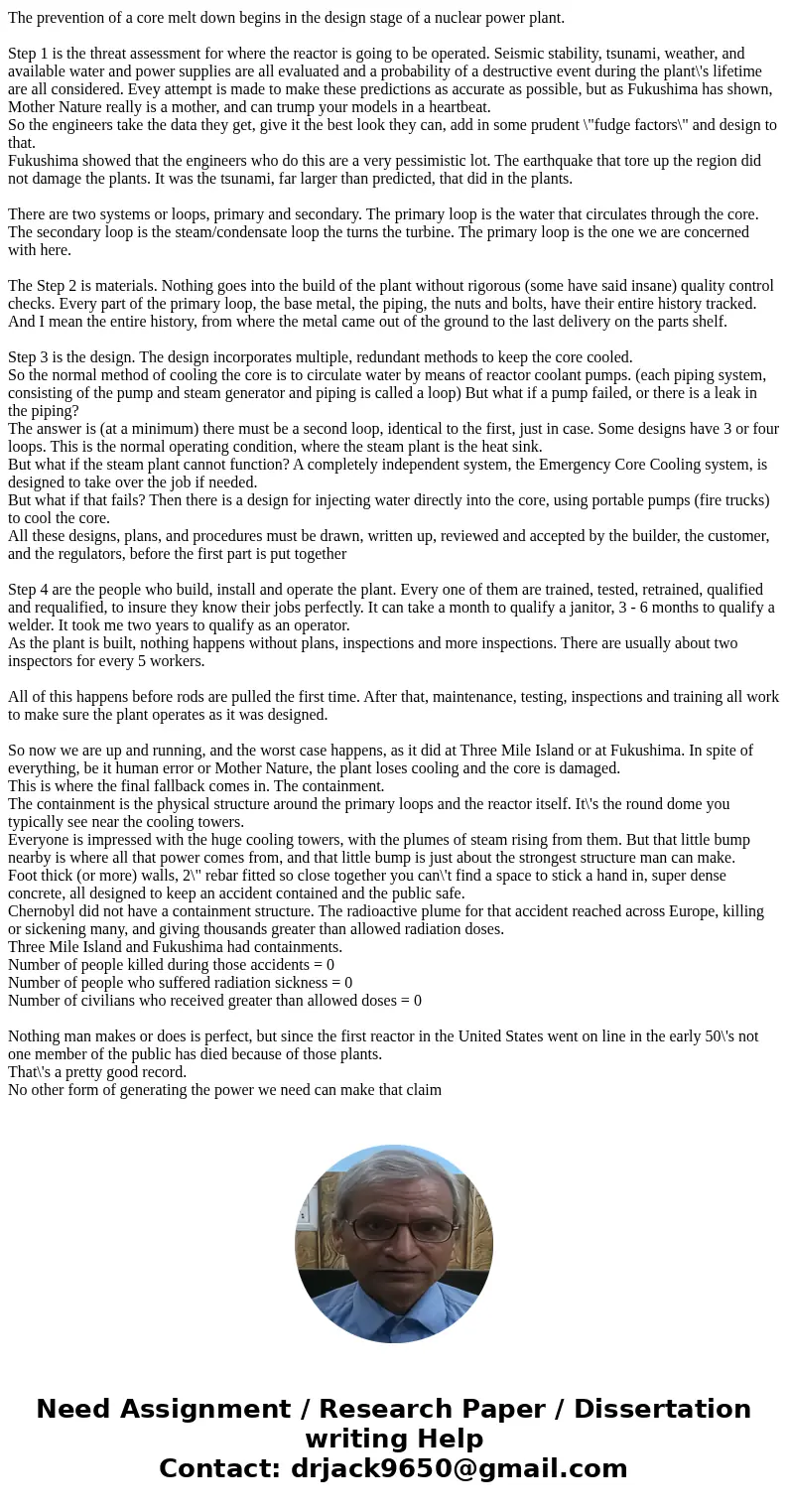what steps can be taken to prevent a core melt down when the
Solution
The prevention of a core melt down begins in the design stage of a nuclear power plant.
Step 1 is the threat assessment for where the reactor is going to be operated. Seismic stability, tsunami, weather, and available water and power supplies are all evaluated and a probability of a destructive event during the plant\'s lifetime are all considered. Evey attempt is made to make these predictions as accurate as possible, but as Fukushima has shown, Mother Nature really is a mother, and can trump your models in a heartbeat.
So the engineers take the data they get, give it the best look they can, add in some prudent \"fudge factors\" and design to that.
Fukushima showed that the engineers who do this are a very pessimistic lot. The earthquake that tore up the region did not damage the plants. It was the tsunami, far larger than predicted, that did in the plants.
There are two systems or loops, primary and secondary. The primary loop is the water that circulates through the core. The secondary loop is the steam/condensate loop the turns the turbine. The primary loop is the one we are concerned with here.
The Step 2 is materials. Nothing goes into the build of the plant without rigorous (some have said insane) quality control checks. Every part of the primary loop, the base metal, the piping, the nuts and bolts, have their entire history tracked. And I mean the entire history, from where the metal came out of the ground to the last delivery on the parts shelf.
Step 3 is the design. The design incorporates multiple, redundant methods to keep the core cooled.
So the normal method of cooling the core is to circulate water by means of reactor coolant pumps. (each piping system, consisting of the pump and steam generator and piping is called a loop) But what if a pump failed, or there is a leak in the piping?
The answer is (at a minimum) there must be a second loop, identical to the first, just in case. Some designs have 3 or four loops. This is the normal operating condition, where the steam plant is the heat sink.
But what if the steam plant cannot function? A completely independent system, the Emergency Core Cooling system, is designed to take over the job if needed.
But what if that fails? Then there is a design for injecting water directly into the core, using portable pumps (fire trucks) to cool the core.
All these designs, plans, and procedures must be drawn, written up, reviewed and accepted by the builder, the customer, and the regulators, before the first part is put together
Step 4 are the people who build, install and operate the plant. Every one of them are trained, tested, retrained, qualified and requalified, to insure they know their jobs perfectly. It can take a month to qualify a janitor, 3 - 6 months to qualify a welder. It took me two years to qualify as an operator.
As the plant is built, nothing happens without plans, inspections and more inspections. There are usually about two inspectors for every 5 workers.
All of this happens before rods are pulled the first time. After that, maintenance, testing, inspections and training all work to make sure the plant operates as it was designed.
So now we are up and running, and the worst case happens, as it did at Three Mile Island or at Fukushima. In spite of everything, be it human error or Mother Nature, the plant loses cooling and the core is damaged.
This is where the final fallback comes in. The containment.
The containment is the physical structure around the primary loops and the reactor itself. It\'s the round dome you typically see near the cooling towers.
Everyone is impressed with the huge cooling towers, with the plumes of steam rising from them. But that little bump nearby is where all that power comes from, and that little bump is just about the strongest structure man can make.
Foot thick (or more) walls, 2\" rebar fitted so close together you can\'t find a space to stick a hand in, super dense concrete, all designed to keep an accident contained and the public safe.
Chernobyl did not have a containment structure. The radioactive plume for that accident reached across Europe, killing or sickening many, and giving thousands greater than allowed radiation doses.
Three Mile Island and Fukushima had containments.
Number of people killed during those accidents = 0
Number of people who suffered radiation sickness = 0
Number of civilians who received greater than allowed doses = 0
Nothing man makes or does is perfect, but since the first reactor in the United States went on line in the early 50\'s not one member of the public has died because of those plants.
That\'s a pretty good record.
No other form of generating the power we need can make that claim


 Homework Sourse
Homework Sourse